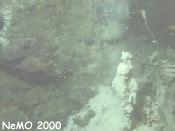| |
Teacher
Logbook:
Saturday, July 8, 2000 1700
hrs.
Overcast skies. A thin
sheath of clouds causes a dull, even-tempered quality to the lighting
outside. No shadows, no bright harsh light. The key word here is light.
We live in a world that ultimately depends on light for survival. Follow
any terrestrial or marine food chain and you will ultimately come to the
sun. Primary producers, the green plants, form the base of food chain.
During the process of photosynthesis they convert water and carbon dioxide,
in the presence of light energy, into oxygen and simple sugars. Consumers,
including humans, depend on these sugars for food. It's simple. No sunlight,
no life.
ROPOS is currently diving
at a vent called Snail. At this diffuse vent there are millions of the
tiny creatures it was named for. Our brief visit for sampling is the only
opportunity they have to experience light, for their world is forever
dark. How then does Snail support primary production? The answer is chemosynthesis.
All vent community animals ultimately depend on chemical energy from vent
fluids instead of light, as the building block for simple sugar production.
Who do the snails have to thank for this? Bacteria and archaea. These
prokaryotic organisms take advantage of chemical energy released from
hydrogen sulfide in the vent fluids to synthesize oxygen and carbon dioxide
into simple sugars. There is life without light.
Microbes flourish growing
in thick off-white mats that cover all the surfaces around the vents.
Sometimes these mats get broken up (termed floc) and float around on bottom
currents giving the water a milky appearance. Whole communities develop
as a result of microbial growth including worms, clams, snails, limpets,
crabs, fish among others. The biodiversity and biomass surrounding hydrothermal
vents is astounding. More than 370 new species have been discovered in
vent regions and 90 percent of these creatures are found no where else.
Population densities exceed those of sunny nutrient-rich coastal waters.
This is a deep-sea paradise that owes its existence to chemosynthesis.
Cindy Van Dover, a prominent vent biologist, stated that "one of the most
significant events in the earth and life sciences in this century was
the realization that hydrothermal activity can support life in the absence
of sunlight."
Jeff
|
|

Jeff filing his daily reports
from the scientist's office aboard the Brown.

Castle Vent, one of the
only high-temperature vents so far discovered on the east side of the
caldera (274degC). Pictured in background is an MTR, tubeworms in the
middle and the anhydrite chimney if the foreground.
|
|

